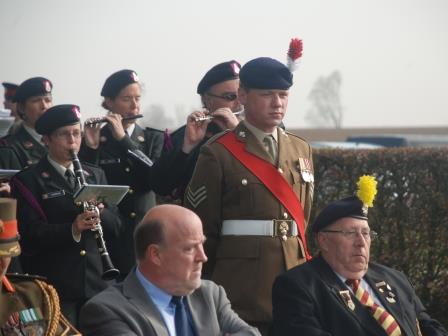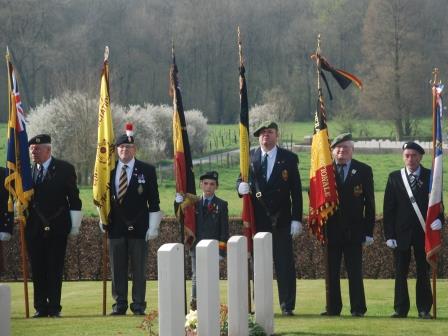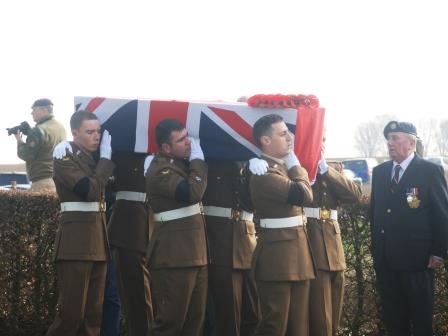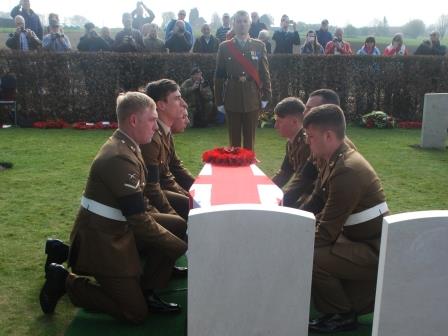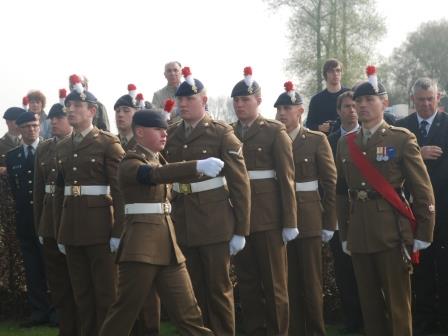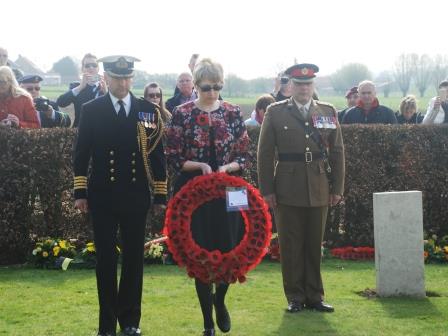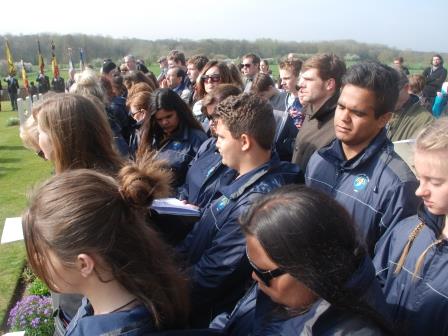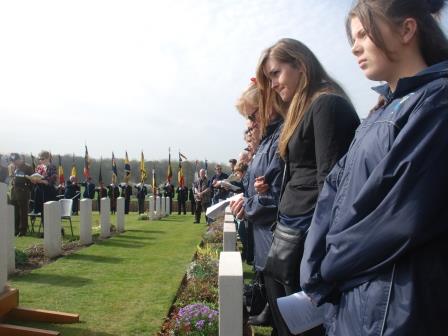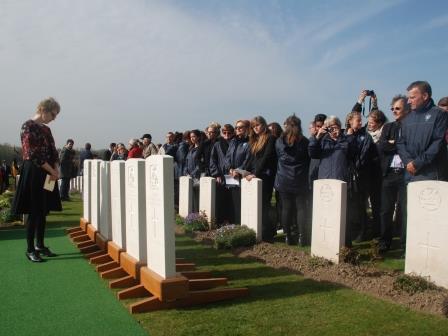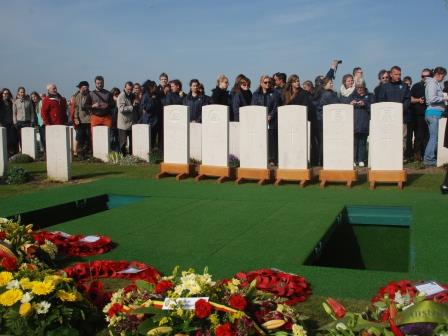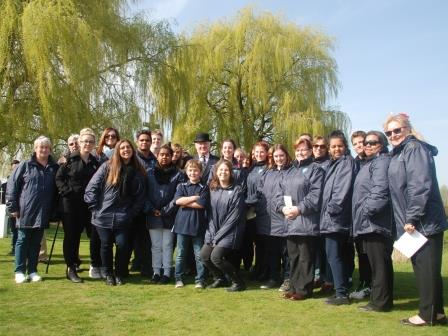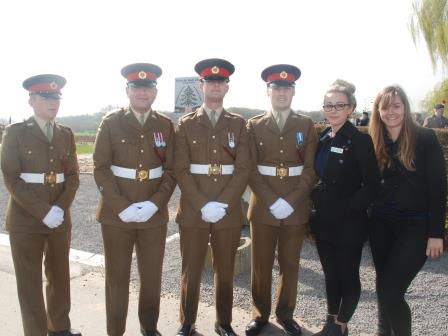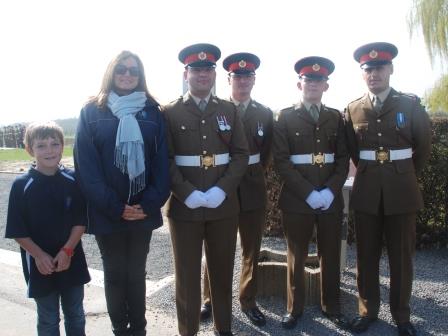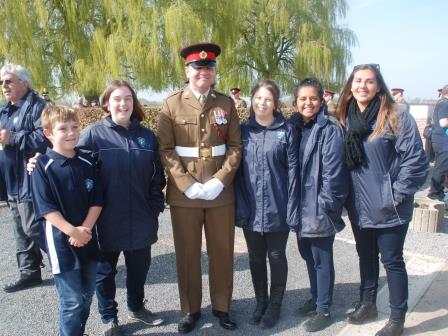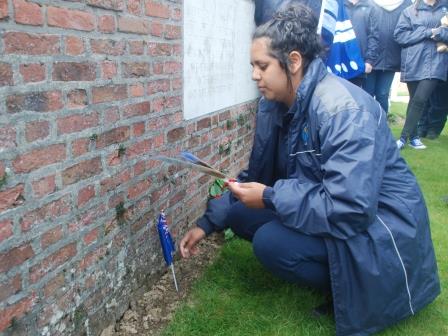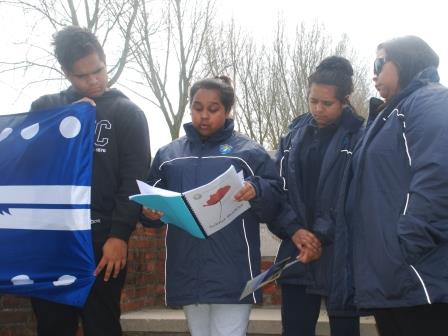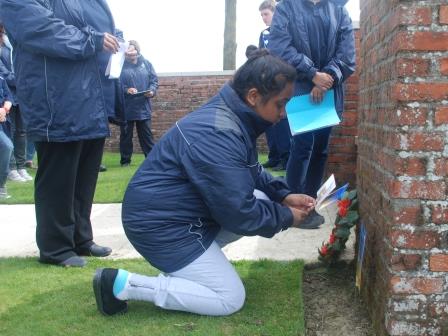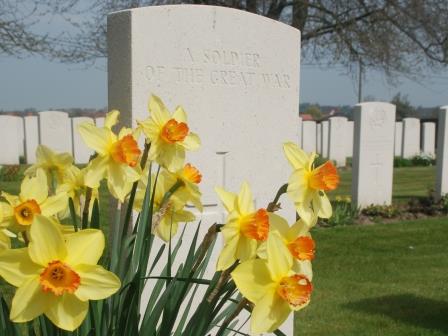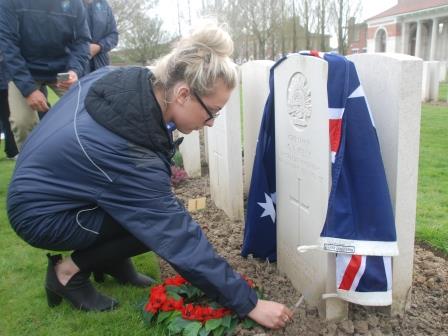April 16th
Day 10 16th April Ypres Salient – Messines Area
A special day in the life of Connecting Spirits. Our guide Rod is the President of the Somme region of the Royal British Legion, similar to our RSL and Legacy combined. In this role he often attends the internment of soldiers whose remains have been recently discovered. As it turns out there were 6 British Soldiers being buried today and Rod asked Julie if she thought we should attend. We weren’t going to let an opportunity like this pass us by, even if it meant changing the itinerary.
The unknown burials were to take place at Prowse Point Cemetery, very near to the site of the Christmas Truce. 2 of the soldiers were known to be members of the Lancashire Fusiliers, 2 from the King’s Own Royal Lancaster Regiment and 2 were not able to be identified at all. Therefore there were representatives from the successors of those two regiments in attendance and the service was conducted jointly by the padre’s of each. We took our places right behind the headstones, a place of honour and were privileged to be able to do so. With due military respect and honour, 4 of the soldiers had been lowered in to the grave early in the morning, leaving 1 from each regiment to be lowered during the service. There was even a firing party which even though we had been warned still surprised us as each coffin was lowered into the grave. A full military band was present and played “Jerusalem” and “I Vow to Thee My Country” as well as the British and Belgian National Anthems, giving the service even more atmosphere and drama.
Jami-Lee Lucas
Today was the burial of 6 unknown soldiers,
The service was short but full of recognition of their duty in the war.
The sacrifice they made for us,
The freedom they created
was shown throughout the service.
The firing party, the draped Union Jack.
The wreath, the soldiers,
the military men and women,
The bishop and the community.
Was all that was needed to show the bravery of these 6
It was all that was needed to show that these men were the true heroes of our world.
Trae Rigney
Amazing day seeing the 6 soldiers laid to rest. Having more than 500 people there from around the world just showed how magical and important this ceremony is for these soldiers. Known only unto god. Very important.
Alex Gorecki
Today we were invited to witness the internment of six British soldiers. My mum met a gentleman from London who is a member of the Royal British Legion named Colin. He was there to lay a wreath on the graves. Colin spent a lot of time talking to my mother and was very interested in our journey and is following us on facebook.
Julie Keast
Watching the burial ceremony of the six British soldiers was something that we were very privileged to experience - possibly something we will never see again. A big thank you to Rod for making it happen for us.
It was a wonderful start to the day, and after the service the girls were quick to get their photos taken with some of the soldiers present. Mind you the soldiers weren’t too reluctant to take part either.
After this we made our way to Bethleem Farm West Cemetery where Cyril Rigney was commemorated by Courtney Rigney. Cyril is not buried in this cemetery, and has no known grave, his name being on the Memorial at Menin Gate. However we know he was in this area when he was killed and so it was decided that this would be an appropriate place to have his commemoration.
We then made our way to Le Plus Douve (Ration Farm) Cemetery. This is close to the jumping off point for the Battle of Messines which Miller Mack was present at as part of the 50th Battalion. This is the only battle he took place in as he took ill and returned to Australia where died of TB in 1919. This is the first time that we have commemorated Miller and again it was decided that this was the most appropriate place for Taylor Long to do so. This is also where Julie’s father’s cousin Bruce Godfree is buried, so we visited him for a less formal commemoration.
Trae Rigney
1st time commemorating Miller Mack, it was emotional standing next to my cousin Taylor. Seeing the tears along her face as she got to the end she felt the hurt and pain the family would of felt, as she couldn't do it my Aunty. Aunty Isobella Koolmatrie, picked her off her feet and finished it off for her. It was special, it was amazing. As she spoke, you could hear the hurt and the strength she had for this moment.
It was then my turn to commemorate my grandmother’s cousin, William Shillabeer at the Kandahar Farm Cemetery.
From here it was off to Poperinghe, which was a town about 10 miles behind the lines and therefore reasonably safe from shelling. Men came here for rest and recreation and often visited the bars and places of “ill repute”. One such establishment was known as Ginger’s Café but is now known as “La Poupee” and is a very nice place to have lunch. Once we were nourished after a long morning, we walked to the shooting post and death cell, where men who had been convicted of a capital offence spent their last night on earth before being taking to the post and “shot at dawn”. Rod gave a very detailed account of the process required for a man to firstly be convicted and then sentenced to death, and finally the process of the preparation for, and execution of, that sentence.
We then made our way to Lijssenthoek Military Cemetery where Julie commemorated Theo Pflaum from Birdwood and I commemorated my grandfather’s 2nd Cousin, Cyril Dunstan Andrew. This is a massive cemetery with 9901 burials with only 24 being unknown. This was next to a hospital behind the lines and therefore most men were identified before they died of wounds or disease and buried here.
We then drove back into France to Armentieres where Tamika commemorated her relative garnet Francis Kelly in the Cite Bonjean Cemetery there.
That evening after tea, the group made its way to the “Magazine” for a musical presentation by Dries. This is the story of one young man, whose grave we saw in Lijssenthoek earlier in the day, and the men in his battalion who died during the period from when he started in the battalion until his own death. There were no battles, just the grind of “Trench Wastage” as men were shot by snipers or hit by shells in the normal routine of trench life. The story uses his own letters home and war records to set the chronology.


